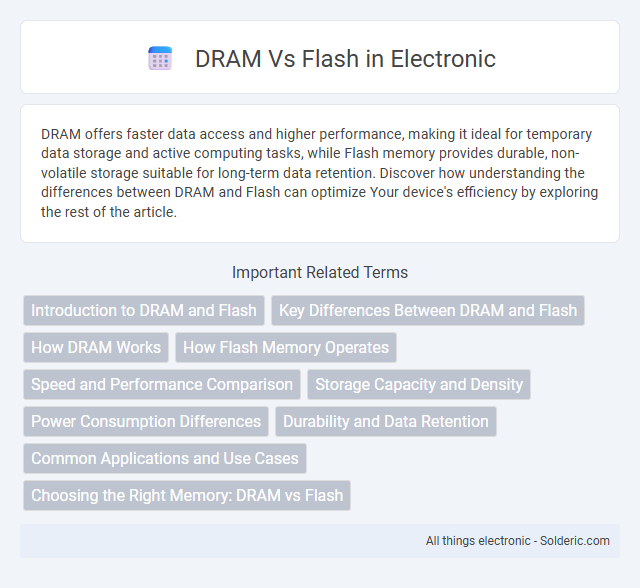DRAM offers faster data access and higher performance, making it ideal for temporary data storage and active computing tasks, while Flash memory provides durable, non-volatile storage suitable for long-term data retention. Discover how understanding the differences between DRAM and Flash can optimize Your device's efficiency by exploring the rest of the article.
Comparison Table
| Feature | DRAM (Dynamic RAM) | Flash Memory |
|---|---|---|
| Type | Volatile memory | Non-volatile memory |
| Data Retention | Requires constant power; loses data when powered off | Retains data without power |
| Speed | Very fast read/write speeds | Slower compared to DRAM |
| Use Case | Main system memory (RAM) | Storage devices (SSDs, USB drives) |
| Durability | High endurance; unlimited write cycles | Limited write/erase cycles (wear out over time) |
| Cost | Higher cost per GB | Lower cost per GB |
| Power Consumption | Higher power consumption | Lower power consumption |
| Density | Lower storage density | Higher storage density |
Introduction to DRAM and Flash
DRAM (Dynamic Random-Access Memory) is a type of volatile memory that stores data using capacitors and requires constant power to maintain information, making it ideal for high-speed, temporary data access in computing devices. Flash memory, a non-volatile storage technology, retains data without power by using floating-gate transistors, commonly found in SSDs, USB drives, and memory cards. The fundamental difference lies in DRAM's rapid data retrieval suited for active processing, while Flash offers persistent storage with slower write speeds and greater durability for long-term data retention.
Key Differences Between DRAM and Flash
DRAM (Dynamic Random Access Memory) offers volatile, high-speed memory ideal for temporary data storage and quick access, whereas Flash memory provides non-volatile storage, retaining data even without power and is commonly used for long-term data storage in SSDs and USB drives. DRAM relies on capacitors to store bits, requiring constant power to maintain information, while Flash memory uses floating-gate transistors to store electrons, enabling persistent storage. Your choice between DRAM and Flash depends on whether you prioritize speed and temporary data handling or durability and long-term retention.
How DRAM Works
DRAM (Dynamic Random-Access Memory) stores data using capacitors and transistors in memory cells, where each capacitor holds an electrical charge representing a bit. The charge in the capacitor leaks over time and must be refreshed thousands of times per second to maintain data integrity. Its high-speed performance and low latency make DRAM essential for temporary data storage in computing systems.
How Flash Memory Operates
Flash memory operates by storing data in an array of memory cells made from floating-gate transistors, which retain electrical charge to represent binary information even without power. Unlike DRAM that requires constant refreshing, Flash memory uses a process called tunneling to trap or release electrons, enabling non-volatile storage that preserves your data when the device is turned off. This structure allows Flash to efficiently support solid-state drives (SSDs) and portable electronics with faster access times and better durability compared to traditional DRAM.
Speed and Performance Comparison
DRAM delivers significantly faster read/write speeds and lower latency compared to Flash memory, making it ideal for real-time processing and applications requiring high performance. Flash memory, while slower, offers non-volatile storage and better data retention without power, which suits long-term storage needs. For your high-speed computing tasks, DRAM provides superior performance, whereas Flash excels in durability and energy efficiency.
Storage Capacity and Density
DRAM typically offers lower storage capacity per chip compared to Flash memory due to its volatile nature and complex cell structure, limiting density improvements. Flash memory achieves significantly higher storage capacity and density by storing multiple bits per cell using advanced multi-level cell (MLC) technology and 3D stacking. As a result, Flash dominates in applications requiring large-scale non-volatile storage, while DRAM excels in speed-sensitive environments with moderate capacity needs.
Power Consumption Differences
DRAM consumes more power than Flash memory due to its constant refresh cycles required to maintain data integrity. Flash memory, being non-volatile, only draws power during read/write operations, resulting in significantly lower overall energy consumption. This power efficiency makes Flash memory ideal for battery-powered devices and applications demanding long battery life.
Durability and Data Retention
DRAM offers high-speed performance but has limited data retention, requiring constant power to maintain stored information, which impacts durability in power-off scenarios. Flash memory provides non-volatile storage with superior data retention capabilities, lasting years without power, making it more durable for long-term data storage. However, Flash memory endures a finite number of write-erase cycles, affecting durability compared to the virtually unlimited write endurance of DRAM.
Common Applications and Use Cases
DRAM excels in applications requiring high-speed, temporary data storage such as computer memory (RAM) for running operating systems and software, gaming consoles, and video editing systems due to its fast read/write capabilities. Flash memory is commonly used in non-volatile storage solutions like USB drives, SSDs, smartphones, and digital cameras, providing reliable long-term data retention even without power. Your choice between DRAM and Flash will depend on whether you prioritize speed and volatility for active processing or durable, persistent storage for data retention.
Choosing the Right Memory: DRAM vs Flash
Choosing the right memory between DRAM and Flash depends on speed, volatility, and use case requirements. DRAM offers high-speed, volatile memory ideal for active data processing, while Flash provides non-volatile storage suitable for long-term data retention and lower power consumption. Understanding these differences is crucial for optimizing system performance and storage efficiency in computing and embedded devices.
DRAM vs Flash Infographic

 solderic.com
solderic.com